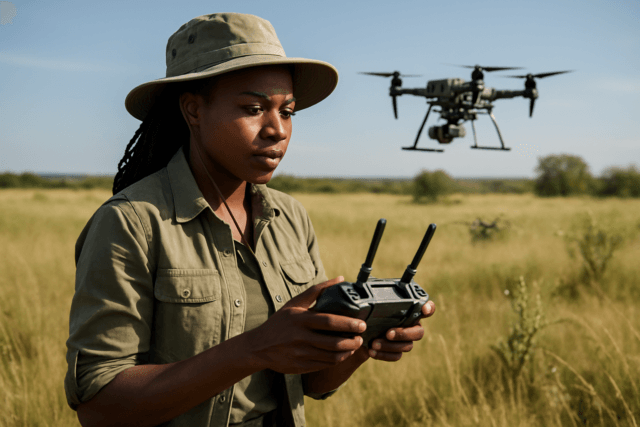In the demanding world of search and rescue (SAR), every second counts. Unmanned Aerial Systems (UAS), commonly known as drones, have rapidly become indispensable tools, offering capabilities that were once unimaginable. Drones provide rapid deployment, cover vast and often inaccessible terrains, and deliver critical real-time data to ground teams, significantly enhancing the efficiency and safety of SAR missions. However, the transformative potential of drones in these life-saving operations is often constrained by a single, critical factor: battery life. Limited flight times necessitate frequent returns for recharging, leading to operational downtime that can jeopardize mission success. Addressing these drone battery limitations with robust and extended field charging solutions is paramount for maximizing their impact in SAR.
The Critical Role of Drones in Search and Rescue
Drones excel in scenarios where human access is difficult or dangerous, such as mountainous regions, dense forests, or disaster-stricken areas. Equipped with advanced sensors like thermal cameras, high-resolution visual cameras, and even LiDAR, they can detect missing persons, assess damage, identify hazards, and map out safe routes for emergency crews. This aerial perspective provides unparalleled situational awareness, reducing the time required to locate victims and plan rescue efforts. The ability to sustain long flights, ideally 45+ minutes, is crucial, especially in remote locations where recharging or replacing batteries is impractical.
Overcoming Drone Battery Life Challenges in Field Operations
Despite their advantages, most commercial drones are powered by lithium-ion (Li-ion) or lithium-polymer (LiPo) batteries, which typically offer flight durations of only 30-45 minutes. Factors such as payload weight (e.g., thermal sensors, communication systems), strong winds, and extreme temperatures can further reduce this endurance. This inherent limitation presents significant challenges for extended SAR operations, requiring innovative drone battery charging solutions to maintain continuous aerial presence.
The Impact of Short Battery Life on SAR Missions
Short battery life directly impacts a drone’s ability to complete long and complex missions. Frequent battery swaps lead to delays, forcing teams to land, replace batteries, and relaunch, losing valuable time during time-sensitive operations. In remote or hard-to-reach areas, the logistical challenge of transporting and charging multiple batteries becomes a major hurdle, affecting the overall effectiveness of drone deployments.
Portable Power Stations and Field Generators
One of the most immediate and widely adopted field charging solutions for drones involves portable power stations and generators. These systems bring the charging capability directly to the mission site, regardless of grid access.
High-Capacity Portable Power Banks
Modern portable power stations, such as the DJI Power 1000 and Power 500, EcoFlow Delta, Jackery, and Bluetti, offer high-capacity, silent, and generator-free solutions. These units are designed for rapid charging, often capable of fully recharging multiple drone batteries and USB accessories simultaneously in 60-90 minutes, or even faster to 80% capacity. For instance, the Colorado Drone Chargers Portable Rapid Charging System (PRCS) is built for rugged environments, able to charge four batteries and two USB accessories simultaneously in approximately 55-65 minutes, powered by inverters or generators. Their portability and ability to charge from various sources (mains power, vehicle 12V systems, solar panels) make them ideal for dynamic SAR environments.
Petrol, Propane, and Hybrid Generators
For prolonged, high-power needs, traditional petrol or propane generators can power multi-battery rapid chargers, offering a robust solution where noise and fuel logistics are manageable. Hybrid systems combining battery banks with small generators offer a balance, allowing silent operation for a period before the generator kicks in to recharge the battery bank and connected devices.
Solar-Integrated Charging
Integrating solar panels with portable power stations or dedicated solar chargers provides a sustainable and off-grid charging option, particularly useful in extended daylight conditions or remote areas. While direct solar charging might be slower, it can augment other power sources, reducing reliance on fuel or grid power.
Hot-Swappable Battery Systems and Drone-in-a-Box Solutions
To minimize downtime and maximize continuous operational time, hot-swappable drone battery systems are gaining traction. This technology allows operators to replace depleted batteries with fresh ones without fully powering down the drone, crucial for maintaining uninterrupted surveillance or data collection.
Automated Battery Swapping
Advanced solutions like “drone-in-a-box” systems integrate automated battery swapping mechanisms. These self-contained stations can house, deploy, recover, and recharge drones autonomously. Upon landing, a robotic arm can quickly swap out a depleted battery for a fresh one, returning the drone to the mission almost instantly. Some systems even employ “hot swapping” where an external power source keeps the drone’s onboard electronics active during the battery change, preventing any data loss. This capability is revolutionary for long-duration missions, enabling drones to operate for hours rather than minutes.
Advanced Charging Technologies and Battery Management Systems
The effectiveness of any drone battery charging solution is significantly enhanced by the underlying charging technology and intelligent battery management.
Rapid Charging and Multi-Port Chargers
Specialized rapid chargers are designed to significantly reduce charging times. Many chargers offer multi-port capabilities, allowing simultaneous charging of several batteries and accessories. Examples include the DJI Mavic 3 5-in-1 Battery Charger and the EV-Peak UD2, which can fully charge multiple batteries in as little as 15-90 minutes depending on the model. These systems often feature intelligent voltage and temperature management, including multi-fan cooling, to ensure safe and efficient charging in various environments.
Intelligent Battery Management Systems (BMS)
A crucial component for optimizing drone battery performance, safety, and longevity is the Battery Management System (BMS). Integrated into modern drone batteries, a BMS continuously monitors critical parameters such as voltage, current, and temperature for each cell. It prevents overcharging, over-discharging, and overheating, which can lead to battery degradation or catastrophic failure. A smart BMS can communicate real-time battery health and telemetry data to the drone’s flight controller or ground control, allowing for better decision-making and extending the usable life of the battery pack.
Wireless Charging Technology
Emerging wireless charging solutions are poised to further enhance autonomy and convenience in drone operations. Systems like WiBotic’s autonomous charging hardware allow drones to land on a pad and begin charging without physical connections. This technology offers waterproof designs, interoperability with different drone types, and increased durability due to the absence of physical contacts prone to wear and tear. Wireless charging pads, often integrated into landing stations, can autonomously recharge drones, simplifying field operations and potentially enabling true 24/7 autonomous missions.
Vehicle-Integrated Charging Solutions
For SAR teams operating in remote or expansive areas, integrating drone charging capabilities directly into command vehicles offers significant logistical advantages.
Mobile Command & Charging Vehicles
Specialized vehicles can be equipped with robust power systems (generators, large battery banks, or solar arrays) and charging infrastructure to support multiple drones simultaneously. These vehicle-integrated drone systems serve as mobile command centers and charging hubs, providing off-pavement, off-grid capabilities. This allows SAR teams to maintain continuous aerial presence over designated areas by rotating drones for patrol and recharging, especially critical during prolonged missions or in vast ocean environments where traditional charging points are non-existent.
Practical Considerations for SAR Teams
When selecting and implementing drone battery charging solutions for extended SAR operations, several practical aspects must be considered:
- Portability and Weight: Equipment must be easily transportable, especially in rugged or remote terrain. Lighter batteries and charging systems are always preferred, allowing drones to carry more payload or fly longer.
- Ruggedness and Weather Resistance: Field equipment must withstand harsh environmental conditions, including extreme temperatures (e.g., -20°C to 45°C), rain, and dust. Protective hard cases with impact resistance, watertight seals, and dust-proofing are essential.
- Charging Speed and Efficiency: Rapid charging capabilities are critical to minimize downtime and maximize operational efficiency.
- Battery Capacity and Management: Matching battery capacities to mission duration and implementing smart BMS features are vital for operational readiness and battery longevity.
- Cost and Training: The initial investment in advanced charging solutions and the necessary training for SAR personnel to operate and maintain them effectively must be factored in.
Future Trends in Drone Battery Technology and Charging
The future of UAS in search and rescue will undoubtedly be shaped by advancements in battery and charging technologies, promising even greater endurance and autonomy.
- Next-Generation Batteries: Researchers are developing new lithium-based batteries with higher energy density, such as lithium-sulfur or sodium-ion, which could significantly extend flight times to several hours. Solid-state batteries are also a promising area, offering even higher energy densities and improved safety by minimizing the risk of overheating and short-circuiting.
- Hydrogen Fuel Cells: Hydrogen fuel cell technology is gaining attention for its potential to provide exceptionally long flight durations (up to three hours) with zero emissions, making it ideal for high-endurance applications like border surveillance and infrastructure inspections.
- Smart Batteries and IoT Integration: Future batteries will be even “smarter,” integrating Internet of Things (IoT) capabilities for real-time data analytics, predictive maintenance, and optimized performance. This will allow for proactive management of battery health and more efficient power allocation within drone fleets.
- Enhanced Autonomous Charging Infrastructure: The development of integrated drone-in-a-box solutions with advanced precision positioning, data communication, and automated battery handling will continue to evolve, making fully autonomous drone operations a widespread reality.
Conclusion
The evolution of drone battery charging solutions is pivotal for realizing the full potential of UAS in extended Search and Rescue operations. By leveraging portable power stations, hot-swappable battery systems, advanced rapid chargers, intelligent battery management, and vehicle-integrated solutions, SAR teams can significantly extend mission endurance and reduce critical downtime. As future innovations in battery chemistry and charging infrastructure continue to emerge, drones will become even more reliable and effective, ultimately enhancing our ability to save lives in the most challenging environments.





